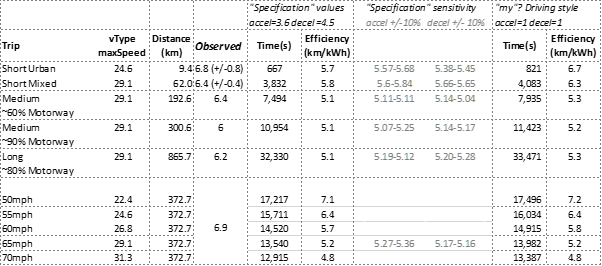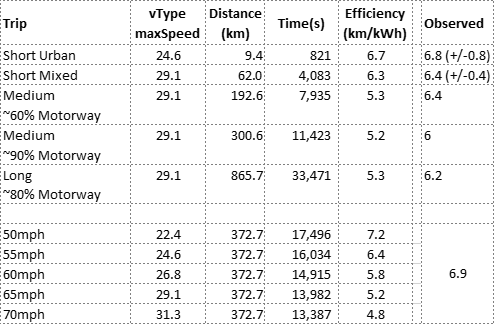[
Date Prev][
Date Next][
Thread Prev][
Thread Next][
Date Index][
Thread Index]
[
List Home]
|
Re: [sumo-user] EV battery consumption values
|
Update:
Jakob pointed out that the acceleration/deceleration values I'd used here were very low - I repeated the exercise using the theoretical (ie "manufacturer specification") value for acceleration and a default for deceleration, then with +/- 10% values for acceleration/deceleration. The latter was run under reduced traffic conditions = higher speeds/lower efficiency.
For the values for which I have multiple real-world data points (short urban/short mixed) the specification acceleration in Sumo shows a reduced efficiency relative to my real world. I might posit that the closer fit of the low acceleration value may reflect my "senior" driving style :)
The updated vType aligned with the vehicle specification is as follows:
<vType id="soulEV65" minGap="2.50" maxSpeed="46.0" color="white" accel="3.6" decel="4.5" sigma="0.0" emissionClass="Energy/unknown">
<param key="constantPowerIntake" value="100"/> <!-- observed summer levels -->
<param key="frontSurfaceArea" value="2.6"/> <!-- computed (ht-clearance) * width -->
<param key="has.battery.device" value="true"/>
<param key="internalMomentOfInertia" value="0.01"/> <!-- guesstimate -->
<param key="maximumBatteryCapacity" value="64000"/>
<param key="maximumPower" value="150000"/> <!-- website as above -->
<param key="propulsionEfficiency" value=".98"/> <!-- guesstimate value providing closest match to observed -->
<param key="radialDragCoefficient" value="0.1"/> <!-- as above -->
<param key="recuperationEfficiency" value=".96"/> <!-- as above -->
<param key="rollDragCoefficient" value="0.01"/> <!-- as above -->
<param key="stoppingTreshold" value="0.1"/> <!-- as above -->
<param key="vehicleMass" value="1830"/> <!-- 1682kg curb wt + my average 2 passengers / bags -->
</vType>
cheers
Div
‐‐‐‐‐‐‐ Original Message ‐‐‐‐‐‐‐
On Monday, November 15th, 2021 at 14:05, The div <div@xxxxxxxx> wrote:
This thread piqued my interest and I've been trying to model the real world behaviour of my own EV (a Kia Soul EV 2020) - so I share this for your amusement!
I extracted a map of England from OSM and cut out an area for which I had trip information.
- specifically some relatively local journeys I have made frequently and a few longer distance journeys which were single data points.
As noted in the thread the values appropriate to a bus considerably overstate the radial drag coefficient for a car - this and the vehicle mass had most impact on my modelling.
Whilst I modelled the exact routes I couldn't model traffic because of the scale and complexity of the longer routes. (I did scale up the simulation to increase congestion in the urban parts of the route and get overtaking behaviour into the motorway route sections but ....) With those caveats I believe SUMO provides very good correlation with my observed efficiency cf:
These routes are on UK roads which have general limits of 30/40mph in urban areas and 70mph on motorways - the specific values having been set by the OSM import.
The variation observed in the real world short routes appears to be temperature related (eg morning vs afternoon). The single data point routes were made in early August.
I played with artificial routes of comparable distances but could not get realistic or even proportionate efficiency outputs - those models always produced much higher efficiency values (double) than can be achieved, a realistic model encompassing junctions, roundabouts etc seems necessary.
I settled on the following vType as being most representative of my driving style - the relative efficiencies gave a comparable ratio to energy consumed/recuperated as reported by my vehicle.
<vType id="soulEV65" minGap="2.50" maxSpeed="29.06" color="white" accel="1.0" decel="1.0" sigma="0.0" emissionClass="Energy/unknown">
<param key="constantPowerIntake" value="100"/> <!-- observed summer levels -->
<param key="frontSurfaceArea" value="2.6"/> <!-- computed (ht-clearance) * width -->
<param key="has.battery.device" value="true"/>
<param key="internalMomentOfInertia" value="0.01"/> <!-- guesstimate -->
<param key="maximumBatteryCapacity" value="64000"/>
<param key="maximumPower" value="150000"/> <!-- website as above -->
<param key="propulsionEfficiency" value=".98"/> <!-- guesstimate value providing closest match to observed -->
<param key="radialDragCoefficient" value="0.1"/> <!-- as above -->
<param key="recuperationEfficiency" value=".96"/> <!-- as above -->
<param key="rollDragCoefficient" value="0.01"/> <!-- as above -->
<param key="stoppingTreshold" value="0.1"/> <!-- as above -->
<param key="vehicleMass" value="1830"/> <!-- 1682kg curb wt + my average 2 passengers / bags -->
</vType>
Whilst these figures model a Soul they should be easily tweaked for any of the Hyundai/Kia EV range that basically use the same electric powertrain.
cheers
Div


